Japanese indoor plants are a unique way to incorporate the Japanese aesthetic into your house. These native Japanese houseplants correspond with the wabi-sabi culture of the country, which focuses on finding beauty in imperfections, impermanence, and incompletion.
After much-curated research on these plants, we have come up with a list of 10 Japanese indoor plants that will be a perfect fit for your house.
With utmost care and patience, (Yes, a lot of it!) these popular indoor Japanese plants will flourish in your care.
Note: Keep in mind that growing Japanese plants indoors is not an easy job. Even the easiest plants require some level of care and attention to thrive well. Be prepared for some extra work, your efforts will truly pay off in the end!
Japanese Aralia
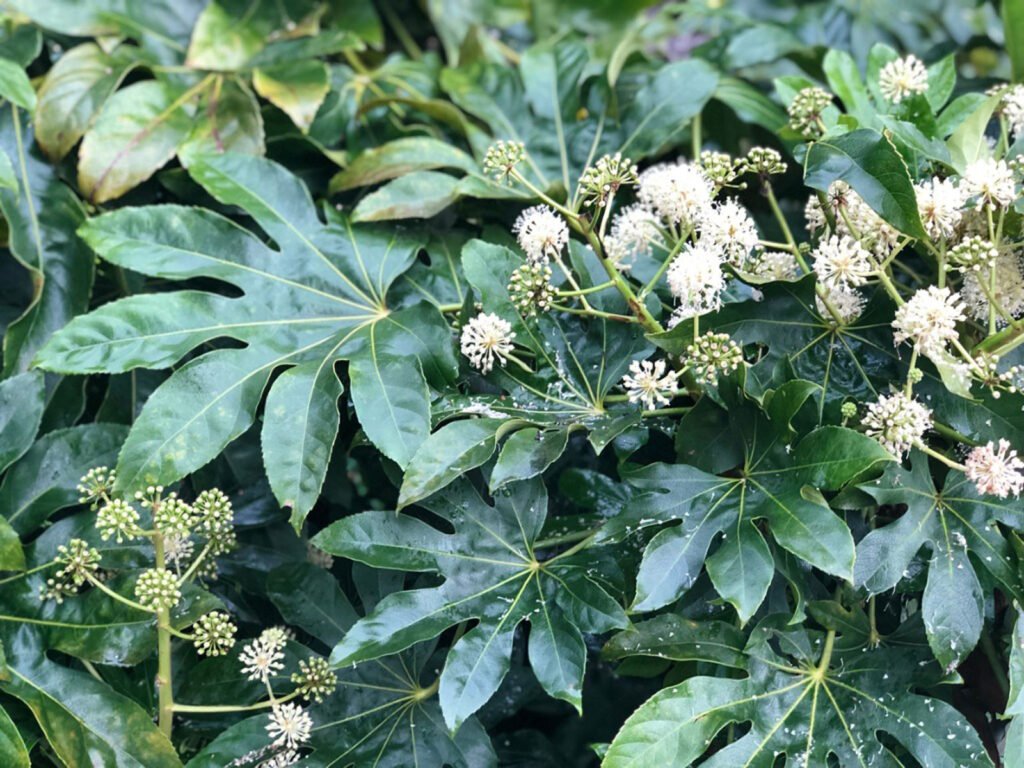
Japanese Aralia(Botanical name: Fatsia japonica) is an easy Japanese indoor plant due to its hardiness. (Go for it if you are black thumbed or have little experience in taking care of plants)
This shrub reaches a height of approximately six meters indoors. It’s known for its large, leather-textured leaves that can measure up to 1 foot across. Besides this, you will be pleasantly surprised to see its small white blooms in autumn!
The best Aralia varieties that serve as Japanese plants indoor are
- Moseri
- Anneise
- Spider’s web
Conditions for growth
The growth conditions necessary for this indoor Japanese plant are
- Partial sun exposure; it can also tolerate shade but prevent placing it in bright, direct sunlight
- Well-drained slightly acidic or neutral soil
- Regular watering is essential for Aralia’s growth. Make sure the soil is always saturated with water. Dry soil or overwatering is doom for these indoor plants. These plants need occasional watering in winter too.
- 60 to 70°F is the optimal temperature for growth. For those of you who cannot survive at 15°C (figuratively), growing Aralia is NOT your cup of tea!
- Make sure to keep them away from strong windy or cold areas in your home. However, an extra humidity source is not needed.
- Liquid fertilizer of weak strength should be given during the summer and spring seasons.
You might feel the growth requirements of these seemingly easy Japanese indoor plants are a little too high but believe us, these are the bare minimum prerequisites that will flourish your plant in no time!
Oh, and you also need to employ a stem-tip cutting method for their propagation and change pots when needed. No biggie, right?
Japanese spindle plant

The Japanese spindle plant is a native plant of China and Japan. This extraordinary ornamental plant, with its thick foliage and leathery leaves, is a signature representative of Japanese flora.
The best Japanese indoor plant variety in this genre is the perennial E. japonicus. (Have you seen the shrubs in movies in the Palace of England? Yes, it will look exactly like that!)
Beware: These alluring plants are extremely toxic to humans and animals! Stay clear of them if you have furry friends or small children in your house. You would not want to risk their lives at all.
Requirements for growth
The growth requirements of this particular indoor Japanese plant are:
- Indirect, bright light (lots of it!)
- Regular watering during the growing season. However, cut back on water supply during winters.
- Make sure to place them in a cool damp place(such as the basement) during winter to initiate their dormancy. (Seriously, who doesn’t want unlimited resting during winters? It’s ‘Netflix and chill’ period all the way!)
- As far as soil is concerned, it can withstand a lot of varieties as long as they are well-drained and moist.
- E. japonicus needs two things: a fertilizer application during spring and a root stimulator.
We would suggest you go for a well-developed plant at the start. You do not want to waste the money you invested on these Japanese indoor plants. However, once you become familiar, you can propagate them through cutting and replanting.
Ficus Bonsai
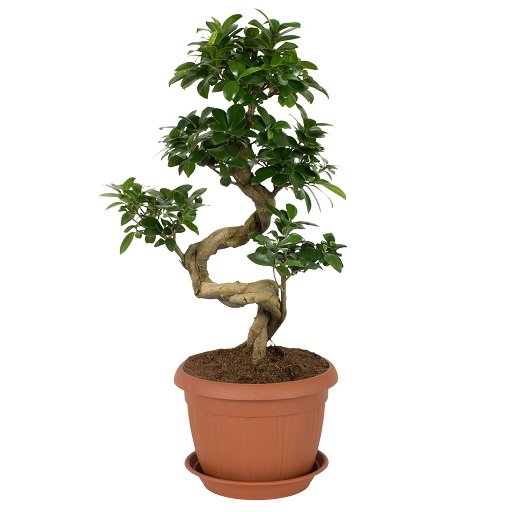
Ficus Bonsai is easily the easiest Japanese indoor plant to grow.
Do you even know what Bonsai is? (You have to be living under a rock to not know this!) Bonsai is the traditional Japanese way of creating small trees that look exactly like their regular version.
Your Japanese indoor plant collection will be incomplete without a Bonsai. But regular Bonsais require a lot of care.
Ficus Bonsai is the best Japanese indoor plant for beginners like you to learn how to take care of these magnificent creatures.
Prerequisites for growth
The growth conditions required for this Japanese dwarf indoor plant’s optimal growth are:
- It needs a lot of light, mostly full sun exposure, for best growth.
- A temperature of 15°C is necessary to maintain it. This indoor plant does not tolerate frost conditions.
- It requires watering, however, it can also survive occasional underwatering (An advantage for us: the ever-forgetful lazy beings!) Note: Do not use fluoride-loaded water at all as it will damage the bonsai
- Adding a moisture source would be a plus. But you should avoid over-misting in all cases.
- Add fertilizer every 2 weeks in summer and monthly in winters.
- You cannot skip pruning and wiring if you want to maintain the shape of your Bonsai. Cut back on foliage and wire new branches to achieve your desired shape.
- Re-pot it every year in spring (don’t forget to prune the roots too at that stage).
Japanese Maple Bonsai
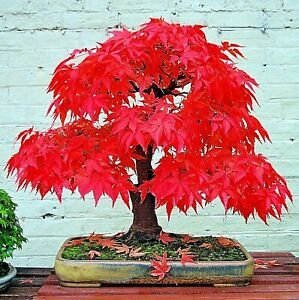
Japanese maple indoor plants are the most extravagant creatures you will get to witness. These popular Japanese indoor plants are ideal for beginners like you who are still learning about caring techniques.
Maple trees, in general, are abundantly found in Japan. In autumn, maple trees set Japanese hills, mountains, and parks on fire(figuratively) with their fiery-colored leaves. (If you are looking to add an authentic Japanese element to your indoor collection, look no further than Japanese maple bonsai.)
Note: The Kuro hime Japanese maple is a great plant for bonsai because it is a dwarf maple, has small leaves, and has a low probability of grafting scars. Leaves emerge with a tinge of red on the edges in spring with red petioles while it has pleasing green foliage in the summertime.
Conditions for growth
The growth requirements of Japanese maple indoor plants are:
- Moderate sunlight
- Being cold-hardy trees, they can tolerate low temperatures (12 to 18°C) and slightly acidic soil pH.
- Water them every day during summer and spring (Yes, there is no exception. Make a note, set an alarm, or do anything you have to do to not forget this!) They also need sporadic watering in winter
- Add fertilizer every two weeks during the growing season, nevertheless switch to nitrogen-free fertilizer during autumn and extend the period to one month.
- Like all bonsai, regular pruning and wiring are necessary to maintain the shape.
- Re-pot young trees every year before spring for best growth.
Pro Tip: Choose Bonsai pots to boost the bonsai aesthetic of your Japanese indoor plants. This will also eventually restrict the growth of your tree.
Japanese painted fern
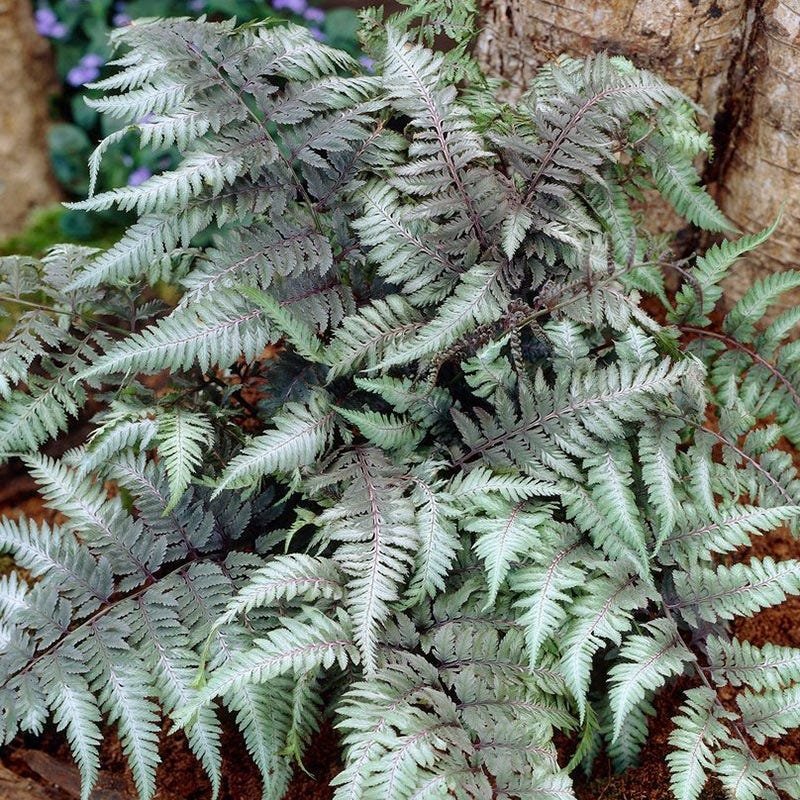
Japanese painted ferns are ideal Japanese indoor plants small in size. These plants are a perfect fit for indoor decoration as they can tolerate a wide range of conditions without wilting away. They grow up to 3 ft in height and 2-3 ft in width. Their leaves are unique, with green and silver color variegation.
Necessities for growth
The growth requirements of these Japanese indoor plants are:
● Partial sunlight or bright indirect sunlight is ideal for its growth. You can try basking this fern in the early morning sunshine.
● Regular watering to maintain moist soil
● Neutral to acidic pH of soil
● Ample humidity boosts the growth of these ferns. You can add a company-made mystifier or DIY it by placing water in an open tray with some pebbles in it.
You will fall in love with the silver-blue fronds of Japanese-painted ferns. You will not regret spending your time on them at all.
Japanese elm Bonsai

Have you heard of the name Zelkova? Japanese elm (Botanical name: Zelkova Serrata) is a native to Japan and Korea. This ornamental tree is grown as a bonsai due to its spectacular dome-shaped dense green foliage.
Its bark is quite unusual too, it’s grayish-white or grayish brown with cuts in it to reveal the inner deep orange bark.
Moreover, you will be enthralled to see its lush orange and bright red color foliage in autumn
Fact: This small Japanese indoor plant is quite resistant to many pests and diseases! You can put your fear away of ruining this plant by common plant diseases.
Conditions for growth
The growth conditions necessary for Japanese elm are:
- Ample sun exposure. Place it preferably at a large, sun-facing windowsill.
- Keep the soil moist at all times. Prevent waterlogging at all costs, it can lead to root rot.
- Add fertilizer in short regular periods during the growth period. However, during the cold season, switch to potassium-rich fertilizer and decrease the frequency of fertilizer addition.
- Trim it regularly and prune it during the winter season to maintain its shape.
- It’s ideal to re-pot it every 2 to 3 years. (The question that arises here: how can you possibly remember the date to re-pot it?!
Our advice is to mark your Google Calendar or write the date on the pot itself so that you do not forget!)
Note: Do not confuse Japanese elm with Chinese elm. You will find this blunder everywhere because both are named Zelkova.
Lucky Bamboo
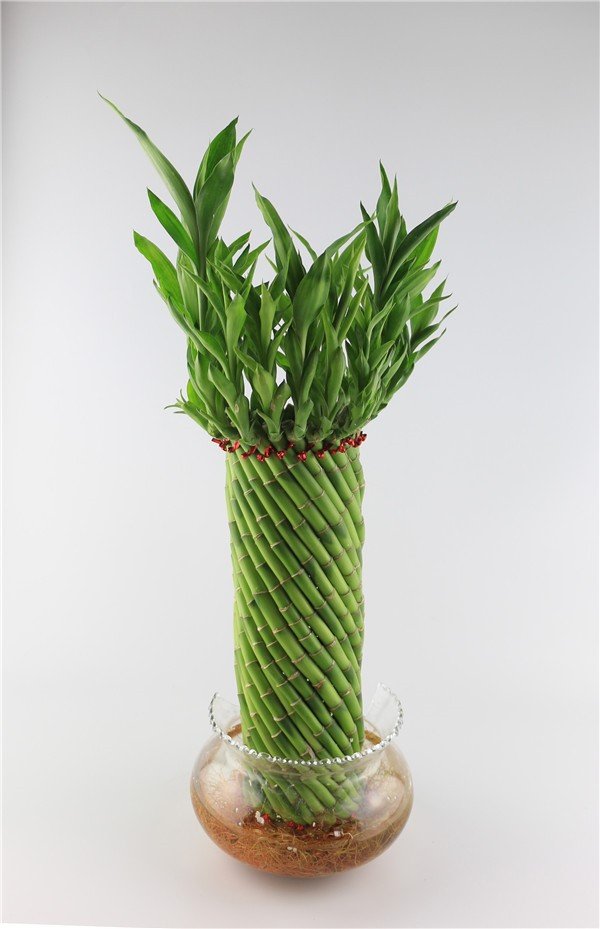
You would think this to be any other bamboo plant by the name, however, this plant is not bamboo at all. It belongs to the Dracaena genus.
Lucky Bamboo has been a part of Feng Shui for more than 5000 years. Do you know what Feng Shui is? It is an art and science that governs the flow of energy (chi) which can be favorable or unfavorable.
Did you know? Lucky bamboo is thought to bring about prosperity, good luck, and happiness. Its hollow structure is linked with a smooth flow of positive energy! It will be a perfect gift to your friends and family (on any occasion). Do not shy away from buying one for yourself too, this also brings about the positive energy associated with it! However, never go for 4-stalk lucky bamboo (which is a bad omen) as it represents death!
This popular indoor Japanese plant is quite easy to care for as it belongs to the Hardiness Zone 10 to 11. This unique plant can also be shaped in spirals, braids, etc to accentuate its charm.
Beware: This plant is, sadly, not a friend to your fur babies. It can be toxic if consumed by pets such as cats and dogs.
Prerequisites for growth
The growth conditions for this plant are
● An indirect light source is enough for its growth
● It thrives well at 18 to 35°C
● If you want to grow it in water, replace the water every week or so. And if you decide to place it in soil, make sure the soil is always moist.
● Fertilizer should be added every month (Mark the first day of every month in your digital calendar! You would not want to forget this.)
Note: Lucky bamboo survives 1 to 2 years in a water vase due to its dainty roots. If you want to prolong its life, place it in soil.
Japanese peace lily
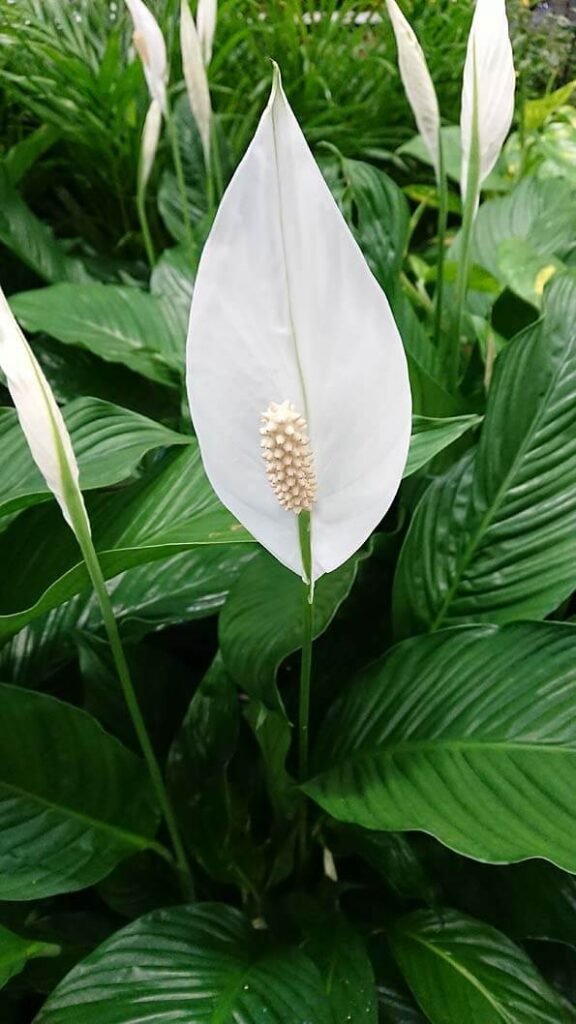
Peace lilies, as the name suggests, as a symbol of peace and harmony. Just like the former, it is also a perfect indoor Japanese plant that you can gift to your loved ones!
Besides this, unlike other plants, peace lilies will droop their leaves when they need water. This sign will alert you to water it before it’s too late.
Requirements for growth
The growth requirements for this awesome plant are quite minimal
● It can grow in shade or partial shade
● Water it abundantly at once. It can also tolerate dry soil (a life-saving option for the oblivious among us!) The best thing would be to water it once or twice a week.
● 65 to 80°F is the ideal temperature range for its growth
● Only use organic fertilizer during the growing season.
P.S. This eye-catching indoor Japanese plant has an added benefit: it also acts as an air purifier. Dope, isn’t it?
Hydrangea

Who hasn’t heard of the famous Ajisai-dera(Hydrangea temple)? This Kamakura district temple boasts vibrant blue-colored Hydrangea bloom clusters, which are unlike anywhere in the world!
This plant is loved by Japanese people and is frequently planted indoors (it flourishes well if you meet its demands.)
Growth requirements
The growth prerequisites constitute:
- It needs a lot of bright indirect sunlight when placed indoors
- A temperature of 10 to 16°C is ideal for its growth
- Water it regularly when it’s blooming. However, decrease the frequency once it blooms
- Add diluted water-soluble fertilizer to the plant when it’s blooming. Extend this period to one month after it blooms
- Adding a humidifier to an airy room is recommended
- Induce dormancy by placing it at 7°C during the winter season, water it lightly during this period.
We understand that it is a lot of work, but their mesmerizing show appeal will make it all worth the effort!
Japanese stonecrop
We have saved the best one for the last!
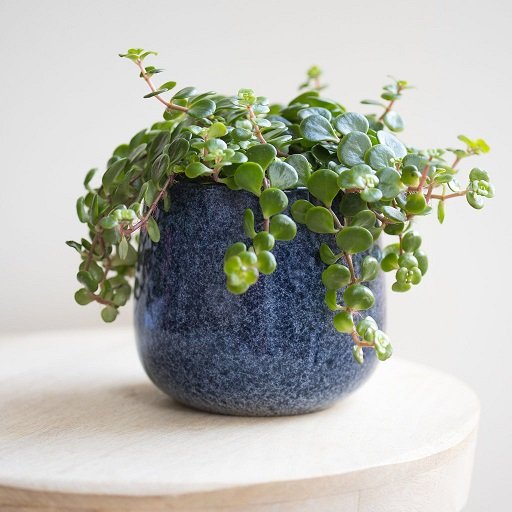
Japanese stonecrops are the hallmark of easy Japanese indoor plants to grow.
Did you know? They are called stonecrops because they require very little care, just like stones. They can survive a range of conditions and will not give in for a long time!
These stonecrops, with their vibrant green succulent leaves, are the ultimate dwarf Japanese indoor plants that are resilient and add luxury to your house collection.
Conditions for growth
The growth conditions needed for this evergreen succulent are very flexible
- It can happily thrive in full sun to part shade
- It is drought-tolerant. Therefore you must let it dry out partially before watering it again.
- During summer, the temperature range of 15 to 25°C would be best. A temperature of 7°C is recommended for winter (This hardy plant can even survive at -5°C! So you do not have to worry about temperature setting at all)
- You do not need a humidifier as it survives in dry to average humidity levels (Stonecrop will save you a lot of money!)
Tip of the day: Have you heard of Kokedama? It is a Japanese way of growing houseplants in moss balls.
If you want to use the hardy plants you already have(such as pothos) to add a Japanese touch to your home, kokedamas(also known as poor man’s bonsai) will be an ideal option for you. But be aware, kokedamas are trendy but hard to keep alive. It’s a lot of work and is only suitable for expert plant enthusiasts!

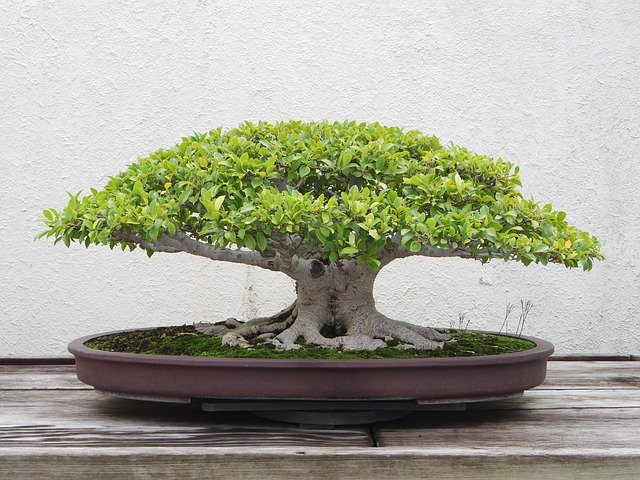
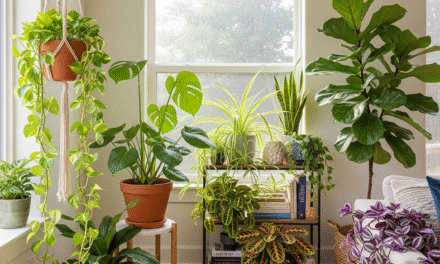

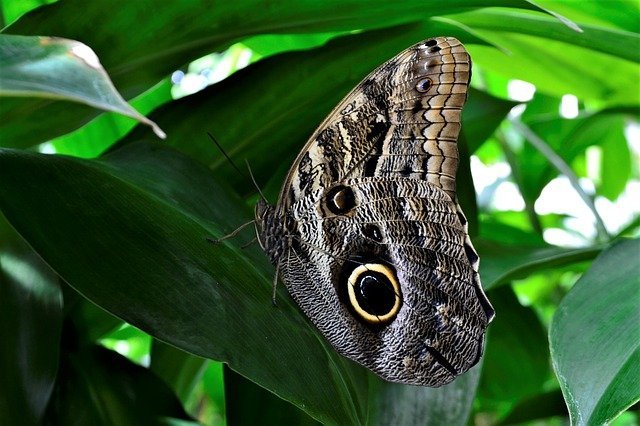
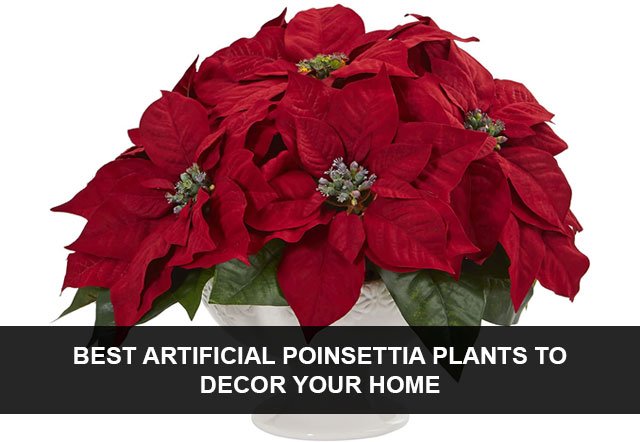
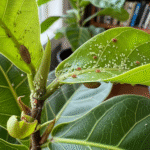
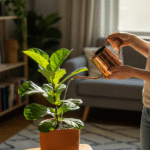
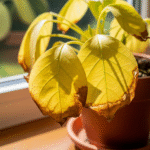
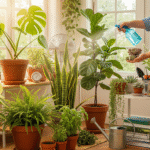
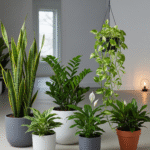
Sustain the excellent work and producing in the group!
Thank you for your post. I really enjoyed reading it, especially because it addressed my issue. It helped me a lot and I hope it will also help others.